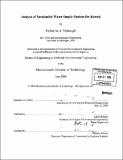| dc.contributor.advisor | Elfaith Eltahir. | en_US |
| dc.contributor.author | Murtaugh, Katharine A. (Katharine Ann) | en_US |
| dc.contributor.other | Massachusetts Institute of Technology. Dept. of Civil and Environmental Engineering. | en_US |
| dc.coverage.spatial | a-ku--- | en_US |
| dc.date.accessioned | 2006-11-07T13:08:23Z | |
| dc.date.available | 2006-11-07T13:08:23Z | |
| dc.date.copyright | 2006 | en_US |
| dc.date.issued | 2006 | en_US |
| dc.identifier.uri | http://hdl.handle.net/1721.1/34582 | |
| dc.description | Thesis (M. Eng.)--Massachusetts Institute of Technology, Dept. of Civil and Environmental Engineering, 2006. | en_US |
| dc.description | Includes bibliographical references (leaves 81-84). | en_US |
| dc.description.abstract | This thesis considers several options for improving the sustainability of Kuwait's water supply system. The country currently relies heavily on desalination and brackish groundwater extraction. The options considered for increasing the flux of potable water into Kuwait include expanding the desalination capacity, importing water from other countries, expanding the uses of reclaimed wastewater, and rainfall harvesting. Options for water storage are also considered, including both aquifer and surface systems. Case studies are presented which demonstrate the potential for indirect potable use of Kuwait's highly purified wastewater, and the importance of a storage reservoir as part of such a system. In order to assess the feasibility of rainfall harvesting, a model was constructed to simulate the runoff processes in the Rawdhatain drainage basin in northern Kuwait. Due to the coarse resolution of the input data, reasonable results could not be obtained using the input parameters gathered from available data. | en_US |
| dc.description.abstract | (cont.) However, through sensitivity analysis, it was discovered that relatively minor variations in soil properties throughout the watershed could produce significant volumes of runoff during extreme rain events. Storage was considered for the small lens of fresh groundwater beneath the Rawdhatain basin or in a surface reservoir constructed in the drainage depression there. All of these options should continue to be considered as Kuwait attempts to expand its water supply in a sustainable manner, though further study will be needed especially in order to understand the hydrologic system at Rawdhatain more thoroughly. | en_US |
| dc.description.statementofresponsibility | by Katharine A. Murtaugh. | en_US |
| dc.format.extent | 139 leaves | en_US |
| dc.format.extent | 8829267 bytes | |
| dc.format.extent | 8835083 bytes | |
| dc.format.mimetype | application/pdf | |
| dc.format.mimetype | application/pdf | |
| dc.language.iso | eng | en_US |
| dc.publisher | Massachusetts Institute of Technology | en_US |
| dc.rights | M.I.T. theses are protected by copyright. They may be viewed from this source for any purpose, but reproduction or distribution in any format is prohibited without written permission. See provided URL for inquiries about permission. | en_US |
| dc.rights.uri | http://dspace.mit.edu/handle/1721.1/7582 | |
| dc.subject | Civil and Environmental Engineering. | en_US |
| dc.title | Analysis of sustainable water supply options for Kuwait | en_US |
| dc.type | Thesis | en_US |
| dc.description.degree | M.Eng. | en_US |
| dc.contributor.department | Massachusetts Institute of Technology. Department of Civil and Environmental Engineering | |
| dc.identifier.oclc | 71249670 | en_US |
